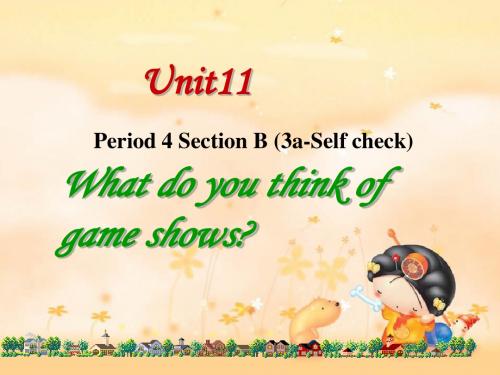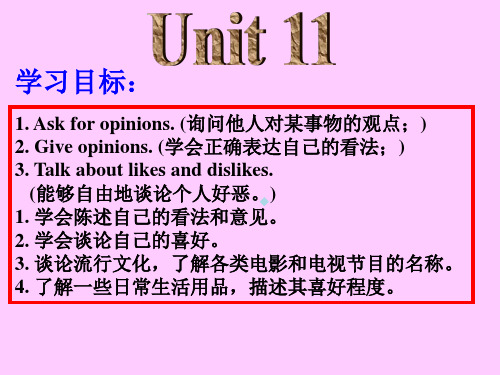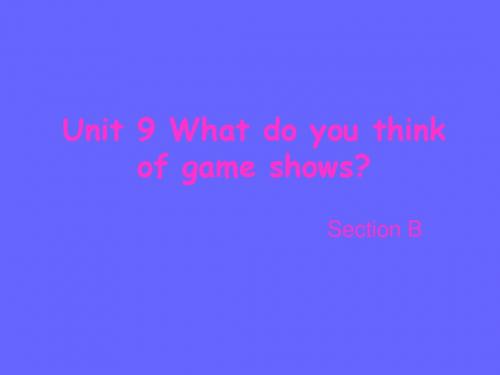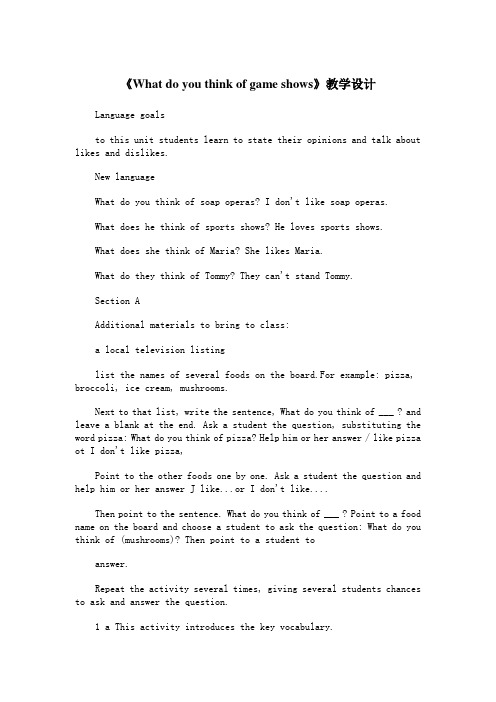What do you think of game showsSection A 1
- 格式:ppt
- 大小:4.99 MB
- 文档页数:61






《What do you think of game shows》教学设计Language goalsto this unit students learn to state their opinions and talk about likes and dislikes.New languageWhat do you think of soap operas? I don't like soap operas.What does he think of sports shows? He loves sports shows.What does she think of Maria? She likes Maria.What do they think of Tommy? They can't stand Tommy.Section AAdditional materials to bring to class:a local television listinglist the names of several foods on the board.For example: pizza, broccoli, ice cream, mushrooms.Next to that list, write the sentence, What do you think of ___ ? and leave a blank at the end. Ask a student the question, substituting the word pizza: What do you think of pizza? Help him or her answer / like pizza ot I don't like pizza,Point to the other foods one by one. Ask a student the question and help him or her answer J like...or I don't like....Then point to the sentence. What do you think of ___ ? Point to a food name on the board and choose a student to ask the question: What do you think of (mushrooms)? Then point to a student toanswer.Repeat the activity several times, giving several students chances to ask and answer the question.1 a This activity introduces the key vocabulary.Focus attention on the five TVs. Say, Each TV shows different kind of TV show. In TV picture a, there is a an playing baseball. This is called a sports show.Talk about the other kinds of shows and ask students what they see. Tell the name of each kind of show as you discuss the picture. Ask students to repeat the names of the shows.Write the word sitcom on the board. Under it write the words situation comedy. Say, The word sitcom comes from the two words situation comedy.A sitcom is a funny show. The people in sitcoms do or say things that make TV watchers laugh.Point out the numbered list of shows. Say each one again and ask students to repeat it.Then ask students to match each TV picture with one of the words. Say, Write the letter of each kind of show next to the correct word. Point out the sample answer.1 b This activity gives students practice in understanding the target language in spoken conversation.Point to the smiley faces and the frowny faces and the words next to them. Read the words to the class or have a student do this. Say, These faces show you what the words mean. If you don't mind something, you don't either like it or dislike it. If you can't stand something, you dislike it very strongly. Your least favorite food is something you can't stand. If you love something, you like it very, very much. Your favorite food is something you love.Say, Now I will play a recording. Listen to what Mark says about the TV shows in la. Write the letter of the TV shows next to the words he uses.Play the recording the first time. Students only listen.Play the recording a second time. Point to the lettered pictures. Say, Each picture has a letter. Point out the blank spaces before the words. Say, Each word or phrase has a space in front of it. Listen to the tape and write the letter of a TV show picture in each blank. Point out the sample answer.Correct the answers.1 c This activity provides guided oral practice using the target language.Point to the pictures of TV shows in activity la and ask students to say the name of each kind of show.Point out the example conversation. Ask two students to read it to the class. Then ask the class to point to the picture of the sitcom.Say a dialogue with a student. Have the student ask ou a question. Then answer it truthfully. Point to the ppropriate picture as you answer.Say, Now work with a partner. Ask and answer the qstions.Have students work in pairs. As they talk, move round the room monitoring their work. Offer anguage or pronunciation support as needed.2a This activity provides listening practice using the target language.Call attention to the list of five "words and expressions.Point out the blank in front of each one. Ask a student to read the list to the class.Say, The people on the recording are talking about TV shows. They use these words and phrases as they talk about the shows. You will number these words and phrases 1-5 in the order you hear them on the recording.Play the recording the first time. Students only listen.Point out the sample answer 1 in front of the word love. Say, The first word on the recording is love in the sentence I love it. So the answer in front o/"love is number 1.Play the recording again. Ask students to write a number from 1 to 5 in front of each of the words and phrases.Check the answers.2b This activity provides more listening practice using the target language.Point out the dialogue with blanks. Read it to the class saying blank each time you come to a blank.Say, Listen to the recording again. This time/ill in each blank with a word or phrase from the list in 2a.Play the recording. Students write words in the blanks.Check the answers.2c This activity provides guided oral practice using the target language.Call attention to the dialogue students completed in activity 2b. Say, Read the dialogue with a partner. \Help students find partners. Have the students practicethe dialogue several times.Then say, Now talk about a TV show you both know.Tell what you like and don't like about the show and the people in it. As students work together, move around the room answering questions and offering language sup- sport as needed.Ask some pairs of students to present their dialogue!to the class.3a This activity provides pral and writing practice using the target language.Call attention to the list of TV shows and ask a student to read the names to the class. Say, In this activity you ask each other questions about TV shows.Ask students to work in pairs. Ask student A in each pair to look at the chart on page 67. Ask student B to look at the chart on page 86. Remind students not to look at their partners' pages.Say the first question and answer with a student. Pretend you are student A and work with a student partner.Say What does Stuart think of "Sports News"? Have student B look at the answer on his or her chart on page 86.Student B answers, Stuart loves "Sports News". Show students that you are writing in the word loves after Stuart's name on the chart on page 67.Then say to your partner, Ask me about Stuart Student B asks, What does Stuart think of "Sports News"? You answer, Stuart likes "Sports News". Have the student write the word likes after Stuart's name on the chart on page 86.Ask the pairs to continue on their own. Move around the room monitoring the progress of the pairs.Go over the answers.3b This activity provides guided reading practice using the target language.Read the dialogue with a student. Every time one of you conies to a blank, say blank.Call attention to the chart students completed in activity 3a. Say, Use the words in this chart to fill in the blanks in the dialogue in activity 3b.4 This activity provides listening, speaking, and writing practice using the target language.Read the instructions to the class. Then ask students to name some TV shows they know about. Write the list on the board. Try to include some that students like and some they don't like.Point out the dialogue in the speech bubbles. Have two students read it to the class.Then point out the sample answer in the chart. Say,This TV show is called "Tell it like it is!" I love it, and Lin Peng does, too. I write "I love it" under "What I think" and I write "Lin Peng" under "Student who agrees with me".Say, Now go around the class. Ask students about TV shows you know. Find students who agree with you.After five minutes ask students to sit down. Then ask some students to read the information from their charts to the class. Ask students to make statements such as I don't like "The Crime Files". Carlos doesn't like "The Crime Files", too.Alternative: If you do not want students to get up andmove around the class, you can ask them to do this activityin groups of four.Section BNew languagehair clip, sunglasses, scarf, watch, wallet, belt, key ring Additional materials to bring to class:mail order catalogs containing watches, jewelry, etc.1 a This activity introduces more key vocabulary.Point out the seven words. Say each word and ask students to repeat it.Call attention to the first picture. Say, Look at picture a.This is a belt. Is anyone in the class wearing a belt? Do the same thing for the other six pictures.Then point out the blank line in front of each numbered word. Ask students to match each word with a picture by writing the letter of the picture in the blank in front of the correct word.Point out the sample answer. As students work, move around the room answering questions as needed.Check the answers.1b This activity provides guided oral practice using the target language.Read the instructions to the class. Then follow the instructions yourself. Hold up or point to each item you have. Then, call on students to hold up items and respond.For example, hold up your wallet and point to your watch.Say, I have a wallet and a watch. What do you have?Ask students to hold up items and tell the class what they have.2a This activity provides guided listening and writing practice using the target language.Say, You ivill hear a conversation. Maria is asking Carol and Evan what they think about different fhings. Write the name of each item under "Thing"in the chart.Play the recording the first time. Students only listen.Point out the example. Say, One thing they are talking about is a watch. "Watch" is written in for you.Play the recording a second time. Students write the names of the things that are being talked about.Check the answers.2b This activity provides more guided listening and writing practice using the target language.Say, Now I will play the recording again. This time,write down what Carol and Evan think about each thing.Ask a student to read the words in the chart to the class.Point out the sample answers as you say, They are talking about a watch. Carol loves the watch. Evan doesn't mind the watch.Play the recording again. This time, have students fill in what Carol and Evan think.Check the answers.2c This activity provides guided oral practice using the target language.Point out the example in the speech bubbles. Ask two students to read it. Show students how it connects with the chart in activity 2a.Say, Now work with a partner. Talk about what his or her parents think about the things in activity 2a.You can use questions and answers like the ones in the speech bubbles.As students work in pairs, move around the room monitoring their work. Offer language support as needed,watch sunglasses scarf wallet3a This activity provides reading and writing practice using the target language.Ask students to read the article individually. Then ask them to say any words or sentences they don't understand.Explain the words and sentences in your own words. For example, if a student asks, What does "It's for moms!"mean? Say, "It's for moms!" means that the scarf is something that a mother wears, not something, thata young person wears.Read the article to the class. After you finish, ask for any more questions.Call attention to the chart on page 88. Point to and read the heading of each column. Say, The first column is a list of things in the article; the second column is loves; the third column is likes; the fourth column is doesn't mind; the fifth column is doesn't like; the sixth column is can't stand.Say, Now read the article again. Write the name of each person in the article in the blank after each item. As students work, move around the room clarifying the instructions and offering other help.Check the answers.4 This activity provides reading, speaking, and listeningpractice using the target language.Read the directions to the class. Point out the speech bubbles. Have two students read the dialogue to the class.Say, Think of six things to ask each other about.What are some things you can think of? Write the words on the board, providing translation help with new words if necessary.Then say, Now go around the classroom. Ask students what they think about six different things. You can use the words on the board or you can use different ones.As students talk, move around the room, monitoring conversations and offering assistance with vocabulary and pronunciation if needed.Alternative: If you do not want students to get up and move around the class, you can ask them to do this activity in groups of four.。
Unit11 What do you think of game shows?Period 1 page 65主备人:审核人:【学习目标】Section A 1a, 1b and 1c.【学习重点】1.词汇:sitcom,soap,mind,stand2.句型: W hat do you think of…?你认为…怎么样?/你觉得…怎么样I like them. / I love them. / I don’t like them. / I can’t stand them. /I don’t mind them.一、课前延伸根据汉语,写出英语。
1.认为,想到:2.游戏节目:3.肥皂剧,连续剧:4.体育节目:5.不能忍受:6.不介意:二、课内探究(一)自主学习1.检查课前预习作业,并教读相应的词汇。
2.看图并完成1a3.完成1c(二)合作探究(1)T:I love sitcoms. What do you think of sitcoms?S1: I love them, too. What do you think of soap operas?S2: I can’t stand. … S3: …… (一个接一个地重复练习该句型)(2)Group work.(以小组为单位,练习上述对话)(3)听录音并完成1b(三)当堂达标连词成句1. soap operas,you,do,what,think,of(?)2. mind , she, doesn’t, them (.)3. can’t , Mark, stand, boring lesson, the (.) 汉翻译成英语。
1.你认为肥皂剧怎么样?do you____ _____ _________?我无法忍受。
太令人厌烦了。
I_______ ______ it. It’s too boring.2.他很喜欢数学课,很有趣。
He math classes. They are三、拓展提升:根据意思填空。
初一英语教材Unit 11 What do you think of game
shows听力Section A 1b
Section A 1b
Jack: What do you think of soap operas, Mark?
杰克:你对肥皂剧是什么看法,马克?
Mark: I don’t like them.
马克:我不喜欢它们。
Jack: What do you think of game shows?
杰克:你对公开比赛是什么看法?
Mark: I love them.
马克:我爱它们。
Jack: What do you think of sitcoms?
杰克:你对连续剧是什么看法?
Mark: Sitcoms? Mmm.I don’t mind them.
马克:连续剧?嗯。
我并没有注意过它们。
Jack: What do you think of sports shows?
杰克:你对公开运动赛有什么看法?
Mark: I like them.
马克:我喜欢它们。
Jack: What do you think of talk shows?
杰克:你对公开演讲有什么看法?
Mark: Talk shows?!! I can’t stand them.
马克:公开演讲?我不会公开演讲。
以上对英语教材Unit 11 What do you think of game shows的听力知识,同学们都能很好的听懂了吧,希望同学们的英语知识学习的很好。
初二年级英语学案设计Unit9What do you think of game shows?淄博世纪英才外语学校李建宁学习目标:1语言目标:What do you think of soap operas?I can't stand them./I don't,either.I love"Tell it like it is"!2能力目标:表达自己的看法----谈论喜欢和不喜欢的事物学习策略与思维技巧:自我评估,个性化学习,小组合作重点词汇:nothing,situation,stand,mind,king,How about…?culture,agree,sunglasses,wallet,by,fashion,show,article,put,cap,idea,colorful,word Period1学习内容及学习目标:学习Unit9中Section A(1a–2c)部分的内容1、掌握以下词汇:talk show,soap opera,sports show,game show,can’t stand,doesn’t mind,How about…?,in fact,…2、初步运用What do you think of…?这一句型,来谈论喜欢和不喜欢的事物。
学习过程:一、找出下列词组(49页)1、认为,想起____________2、谈话节目________________3、肥皂剧________________4、体育节目______________5、sitcom=situation comedy_________6、游戏节目_____________7、不介意_______________8、不能忍受_______________9、实际上________________10、......怎么样?_________________二、听对话填空(1b,Section A)Jack:What do you______soap operas,Mark?Mark:Idon't like____.Jack:What do you think of game shows?Mark:Ilove them.Jack:What do you think of____?Mark:Sitcoms?Mmm.Idon't___them.Jack:What do you think of_______?Mark:Ilike them.Jack:What do you think of______?Mark:Talk shows?I_______them.三、听力(2a,2b,sectionA)2a Listen and number the expressions as you hear them.2b listen and fill in the blanks.四、重难点突破1、What do you think of...?=How do you like...?你认为......怎么样?(谈论对事物的喜好)回答有:(1)I like it.(2)I don't mind it.(3)I don't like it.(4)I can't stand it.(5)I like it very much.(6)l love it.2、How about you/him?How about writing a letter?=What about writing a letter?3、nothing=not...anythingHe has nothing in his house.=He doesn't have anything in his house.There is nothing in the room.(nothing做主语,谓语动词用单数)五、小组练习1、What do you think of talk shows?Ilove them.How about you?Idon't like them,but my mother can't stand them.2、你能将画线处用其他词替换并告诉同学不同的看法吗?What does your brother think of red?He can't stand it./He doesn't mind it.Why?Because…习题巩固:一、用所给词的适当形式填空1.The girls enjoy___________(sing)this song in English.2.Do you mind me____________(open)the window?3.Thank you for___________(join)us.4.----How do you like Chinese cooking?----Oh,I don’t stand it.__________(cook)is for moms.5.How about____________(play)football after school?二、单项填空()1.----______do you_______sitcoms?----I love them.A.How,think ofB.What,like ofC.What,think ofD.What,like()2.He looks rich,________,he is very poor.A.In the factB.In factC.At the factD.At fact()3.I enjoy pop music,_____you? A.How about B.How are C.What do D.What are()4.________9o’clock Weekend Chat,Stuart.Do you like_______TV?A.Welcome,to watchB.Welcome to,to lookC.Welcome to,watchingD.Welcome,watching()5.----Do you______me?----Yes,I love it very much.A.agreeB.agree withC.agreedD.agree for这节课我学到了_________________________________________________________Period2学习内容及学习目标:学习Unit9中Section A(3a–4)部分的内容1、掌握以下词汇:Welcome to…,a thirteen-year-old boy,sunglasses,scarf,wallet2、进一步巩固What do you think of…?这一句型以及回答(love,like,don’t mind,don’t like,can’t stand等),来谈论喜欢和不喜欢的事物。
Unit 11 What do you think of game shows?陆圈一中张二凡一.单元简析:本单元主要讨论电视节目及一些日常生活用品,从而让学生学会陈述自己的看法和意见。
并且会讨论自己或询问他人对事物的喜好程度,看法意见等。
从而增进与家人,朋友,同学之间的了解。
二.教学目标1.学习一些电视节目,日常生活用品单词并会讨论自己的看法和喜好。
2.能表达自己对不同话题的看法和意见。
3.了解生活用品的重要性,增进与家人,朋友的沟通。
三.教学重点,难点重点:1)Lean and master some new words about TV shows and life supplies.2) Lean to express the likes and dislikes难点:Describe the reasons of likes and dislikes四.本单元教具收集电视节目图片,一些实物,及多媒体课件五.本单元重点单词及短语In fact how/ what about …? Can’t stand don’t /doesn’tmind what do you think of . . .= how do you like. . .thanks for doing sth . . . agree with sb…. A pair ofsunglasses六.本单元新单词超超练:1)The tiger is the k of the animals.2)In f , I like Engish very much.3)How a playing the piano?4) A: I can’t s sports shows , They are boring.B: I don’t m .5) N is difficult if you study hard.6) Let’s go to the zoo.Good i .7) She doen’t a with me. She thinks I’m wrong.8) Chinese c is different from other courtries.9) Zhu Jun is my favorite h .10) I like wearing c clothes in summer .七.挑战自我自由练(动词填空)1)She enjoys (watch) movies.2) Thank you for ( teach) me math.3) He likes (comedy).4) Cooking ( be) for Moms.5)Do you mind (close) the door?6) Let’s ( talk ) about the sitcoms.7) What do you think of (swim).8) Do you like these ( scarf)?八.Teaching StepsSection AStep 1: 1) Greetings2)New words 借助幻灯片出现各种各样的电视节目从而导入新单词:talk show soap opera sports show sitcomgame show 等等Step2: Teach and ReadTeach them several times and give them some time topracticeStep 3: New drillsT: Which TV shows do you like or dislike?S: I like…( 展示一个笑脸)I dislike …(展示一个哭脸)并板书出下列句型:I love…I like…I don’t mind…I can’t stand等等Step4: Practice老师作出示范:T: What do you think of sports shows?= How do you like sports shows?S: I love them.出示幻灯片,让学生操练句型。